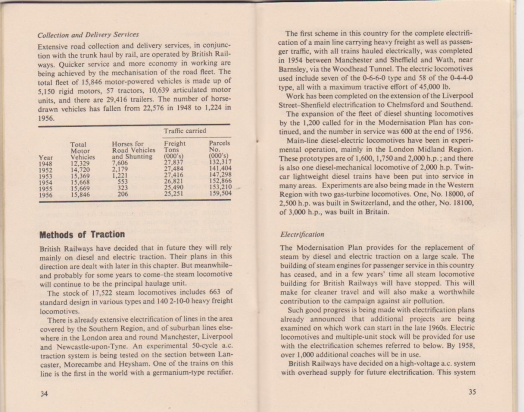Dieselisation and electrification
Resource Type: Image | Posted on 7th November 2011 by Liam Physick
This double-page spread from the 1957 edition of Facts and Figures about British Railways gives information on the progress of the 1955 Modernisation Plan, which led to the complete replacement of steam by diesel and electric traction by 1968. This pamphlet was, of course, published when the Plan was still in its early stages, hence its acknowledgement that “meanwhile - and probably for some years to come - the steam locomotive will continue to be the principle haulage unit”. Nevertheless, “The building of steam engines for passenger service in this country has ceased, and in a few years’ time all steam locomotive building for British Railways will have stopped” - the last steam locomotive on BR was built in 1960, three years after this pamphlet came out. The pamphlet goes on to describe the electrification of railway lines, the expansion of the number of diesel shunters and the experimental use of main-line diesel-electric locomotives. As for future developments, electric locomotives and multiple units will be built to use the electrified lines. The extract here also briefly mentions one of the benefits of the Modernisation Plan: “This will make for cleaner travel and will also make a worthwhile contribution to the campaign against air pollution”. It does not mention the many problems with the implemention of the Plan. A number of the electrification schemes about which the pamphlet boasts had to be shelved. Steam engines were replaced by diesels on a like-for-like basis, thus failing to appreciate how local and branch line traffic was declining owing to competition from roads. Many of the large number of diesel shunters constructed, which the spread proudly refers to here, were scrapped within a few years due to the rise of container freight. As BR was losing money heavily, diesel locomotives were often rushed into service with little testing, and thus often failed, so steam engines would have to take over their trains: again, many were soon scrapped. Finally, right up until 1955, BR had continued to build steam locomotives: when the report was issued they were still the dominant mode of rail transport, as the extract tentatively acknowledges. As a result, (again due to the desire to modernise as quickly as possible to reverse the falling of profits) many steam locomotives were scrapped within a few years of being built, when they still had many years of reliable service left in them, and often before there was a reliable and practical diesel or electric alternative
Categorised under: Landmarks, Landscapes & Locomotives

Comments